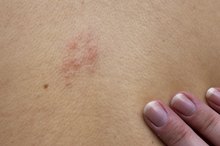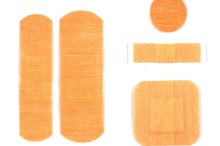How to Use Micropore Tape on a Scar
Micropore tape is a paper tape used to dress wounds and secure medical tubing. It is also commonly recommended to minimize post-surgical scar formation. Micropore tape allows skin to breathe while protecting the area from stenting. Stenting pulls the wound in a way that can cause thick scars to develop. Micropore tape secures the skin and helps prevent pulling. Application of this tape is straightforward.
Clean the area thoroughly with warm water and mild soap. If the scar is fresh, follow your doctor's instructions for wound care. Pat the region dry with a clean towel.
Read more about the healing stages of scars.
Care of Skin After Cryosurgery
Learn More
Rip or cut the appropriate section of tape. Avoid touching the sticky side of the tape.
Lay the section of tape across the scar. Cover the area completely with the tape.
How to Get Rid of Shingle Scars
Learn More
Apply pressure to the tape by running your fingertip along the surface or pressing the palm of your hand on top of the tape. Rub the tape into place. According to 3M, laying the tape on the area will not provide enough contact to support a strong hold. Gentle pressure will attach the adhesive to skin surface.
Leave the tape in place for 24 hours and then remove it. Change the tape more often if instructed by your doctor. To remove, grasp one end with your fingertips and gently pull back. Clean the area and apply new tape. Plastic surgeon, Dr. Paul Belt, recommends use of Micropore tape for six weeks 1.
Read more about remove adhesive tape from your skin.
Warnings
Do not use tape to encircle a limb. This may cut off the circulation.Only use Micropore tape after surgery if recommended by your physician.
Related Articles
References
- Dr. Paul Belt: Scar Revision
- 3M Micropore Surgical Tapes: Commonly Asked Questions
- Al-subahi M, Alayat M, Alshehri MA, et al. The effectiveness of physiotherapy interventions for sacroiliac joint dysfunction: a systematic review. J Phys Ther Sci. 2017;29(9):1689-1694. doi:10.1589/jpts.29.1689
- Do-Yun Shin and Ju-Young Heo. The Effects of Kinesiotaping Applied onto Erector Spinae and Sacroiliac Joint on Lumbar Flexibility. J Kor Phys Ther 2017;29(6):307-315. doi:
- Selva, F., Pardo, A., Aguado, X. et al. A study of reproducibility of kinesiology tape applications: review, reliability and validity. BMC Musculoskelet Disord 20, 153 (2019) doi:10.1186/s12891-019-2533-0
- Daniel H. Craighead, Sean W. Shank, Kyle M. Volz, and Lacy M. Alexander Kinesiology Tape Modestly Increases Skin Blood Flow Regardless of Tape Application Technique Journal of Performance Health Research Volume 1, Issue 1. Pages 72-78. doi:10.25036/jphr.2017.1.1.craighead
Writer Bio
Writing since 1999, Darla Ferrara is an award-winning author who specializes in health, diet, fitness and computer technology. She has been published in "Mezzo Magazine" and Diet Spotlight, as well as various online magazines. Ferrara studied biology and emergency medical technology at the University of Nebraska and Southeast Community College.








